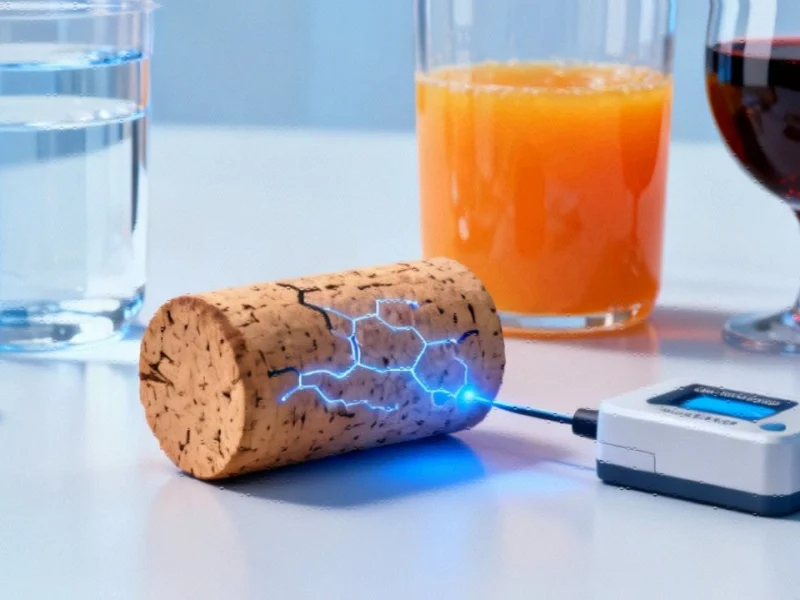Note: Featured image is for illustrative purposes only and does not represent any specific product, service, or entity mentioned in this article.
Innovative Detection Method for Harmful Preservatives
A groundbreaking sensor technology developed by Brazilian researchers is set to transform how the beverage industry monitors product safety. Scientists at the Federal University of São Carlos (UFSCar) have created a novel detection system using laser-modified cork that can identify sodium nitrite contamination in various drinks with unprecedented simplicity and cost-effectiveness.
According to Professor Bruno Campos Janegitz, head of UFSCar’s Laboratory of Sensors, Nanomedicine, and Nanostructured Materials (LSNano), the motivation stemmed from growing concerns about food safety. “The health risks associated with sodium nitrite contamination drove our team to develop this accessible detection method,” Janegitz explained. “Our goal was to create something that could ensure liquid consumption safety without requiring complex laboratory equipment.”
The Science Behind the Sustainable Sensor
The research team employed an ingenious approach by transforming ordinary cork into a highly conductive graphene material through laser treatment. This process, described in the journal Microchimica Acta, creates conductive pathways in the cork without requiring toxic chemicals or expensive materials. “The laser marking essentially draws conductive patterns in the cork, creating an ideal platform for electrochemical detection,” Janegitz noted.
Following the laser treatment, researchers applied a waterproof coating to prevent liquid absorption that could compromise sensor accuracy. A layer of nail polish was then used to define the active detection area before the sensors underwent optimization in controlled drying conditions. This innovative approach to sensor development represents a significant advancement in sustainable detection technology.
Broad Applications Across Beverage Industries
The sensor’s effectiveness was validated across multiple beverage types, including mineral water, orange juice, and wine. In Brazil and most countries, sodium nitrite use in beverages isn’t legally permitted, making detection crucial for quality control. The researchers demonstrated that their sensor could detect nitrite concentrations relevant to food safety standards with high sensitivity and stability.
This technology arrives amid broader industry developments in detection and monitoring systems across various sectors. The beverage industry in particular stands to benefit from such innovations as consumers become increasingly concerned about product safety and ingredient transparency.
Health Implications and Detection Importance
Sodium nitrite, while approved as a preservative in certain meat products, poses significant health risks when present in beverages. The compound can lead to the formation of nitrosamines—carcinogenic substances linked to various health problems. “Depending on concentration levels, sodium nitrite contamination can create serious public health concerns,” the research team emphasized in their published paper.
The development of accessible detection methods coincides with other recent technology advancements that are making sophisticated testing more widely available. This democratization of detection capability represents an important trend in food safety innovation.
Future Development and Commercial Potential
While the sensor currently remains in laboratory validation phases, the research team acknowledges the need for design improvements before practical implementation. The project aligns with LSNano’s broader mission to develop low-cost platforms that generate added value while respecting environmental considerations.
The innovation emerges during a period of significant market trends toward sustainable manufacturing and detection solutions. As industries increasingly prioritize environmental responsibility, technologies like the cork-based sensor demonstrate how natural materials can be transformed into sophisticated detection platforms.
Looking forward, the research team sees potential for this technology to be adapted for detecting other contaminants, potentially revolutionizing how food and beverage quality is monitored throughout production and distribution chains. This development reflects the broader movement toward related innovations that are making advanced detection capabilities more accessible across multiple industries.
Industry Impact and Implementation Timeline
The sensor technology represents a significant step forward in portable, affordable detection systems. Unlike traditional laboratory methods that require expensive equipment and trained technicians, the cork-based sensor could potentially be deployed at various points in the supply chain, from production facilities to quality control checkpoints.
As the technology progresses from laboratory validation to commercial application, it could provide beverage manufacturers with a powerful tool for ensuring product safety while minimizing the environmental impact of their quality control processes. The use of cork—a renewable, biodegradable material—further enhances the sustainability profile of this innovative detection method.
This article aggregates information from publicly available sources. All trademarks and copyrights belong to their respective owners.



